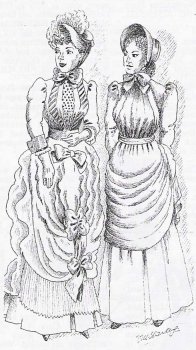The Lady’s
Maid
Duties
 |
As the personal
servant of m’lady, the lady’s maid occupied
a high rung on the servant’s ladder. Like the housekeeper and cook,
her day began a little later than that of the housemaids. Her first
task in the morning was to wake her mistress with tea (usually at The maid
assisted her mistress in dressing, undressing and redressing, maintaining
a pleasant and willing demeanour throughout. She was expected to be
au-fait with the latest fashion and hairdressing styles, matching colours
and styles to her ladyship’s figure and complexion. She also maintained
her ladyship’s wardrobe and jewellery, and made and administered her
beauty lotions. Needlework
skills were essential to the job and many lady’s
maids had formal training in dress-making and millinery. The successful
maid was expected to be honest, not prone to gossip, and neat in person
(fringes, for example, were considered untidy). She should read and
write well, as her job might involve reading aloud to her mistress.
To this purpose, The Complete Servant recommended that, “she will, at her leisure, practise reading aloud, from the best authors… avoiding, alike, the
dull
monotony of the school girl, the formal affectation of the pedant” (1825).
|
|
Olive
Sharkey 1998,30
|
Lady’s maids at Emo Court
With her airs and
graces, the lady’s maid was often an unpopular figure among the other servants,
and her intimate relationship with the mistress made her suspected of
tale-bearing. Yet the lady’s maid at
The lady’s maid at